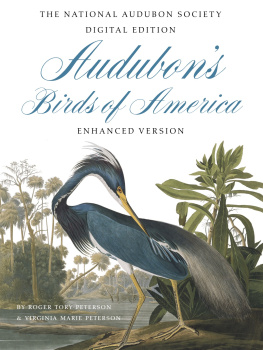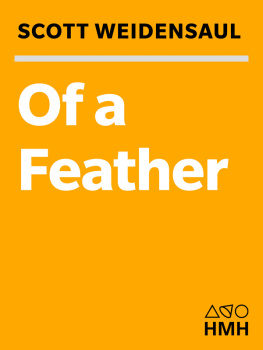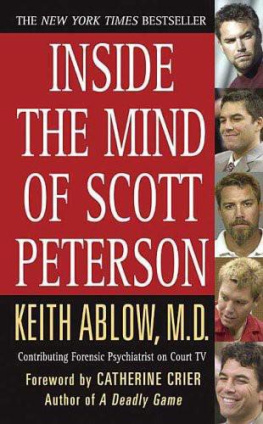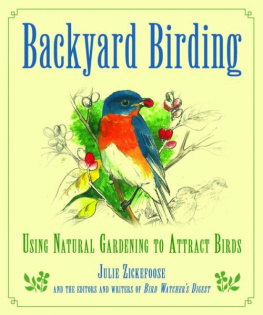First Houghton Mifflin paperback edition 2007
Essays and photographs copyright 1984, 1985, 1986, 1987, 1988, 1989, 1990, 1991, 1992, 1993, 1994, 1995, 1996 by the Estate of Roger Tory Peterson
Compilation, Introduction, and annotations copyright 2006 by Bill Thompson III
All rights reserved
For information about permission to reproduce selections from this book, write to Permissions, Houghton Mifflin Harcourt Publishing Company, 215 Park Avenue South, New York, New York 10003.
www.hmhco.com
The Library of Congress has cataloged the print edition as follows:
Peterson, Roger Tory.
All things reconsidered: my birding adventures / Roger Tory Peterson; edited by Bill Thompson III.
p. cm.
Includes index.
ISBN -13: 978-0-618-75862-3
ISBN -10: 0-618-75862-3
1. Bird watchingAnecdotes. 2. Peterson, Roger ToryTravel. I. Thompson, Bill. II. Title.
QL 677.5 P 384 2006
598.072'34dc22 2006009769
ISBN -13: 978-0-618-92615-2
ISBN -10: 0-618-92615-1
All photographs and illustrations by Roger Tory Peterson unless otherwise noted, with the exception of those on pages , whose copyright holders are unknown.
e ISBN 978-0-547-52780-2
v2.0414
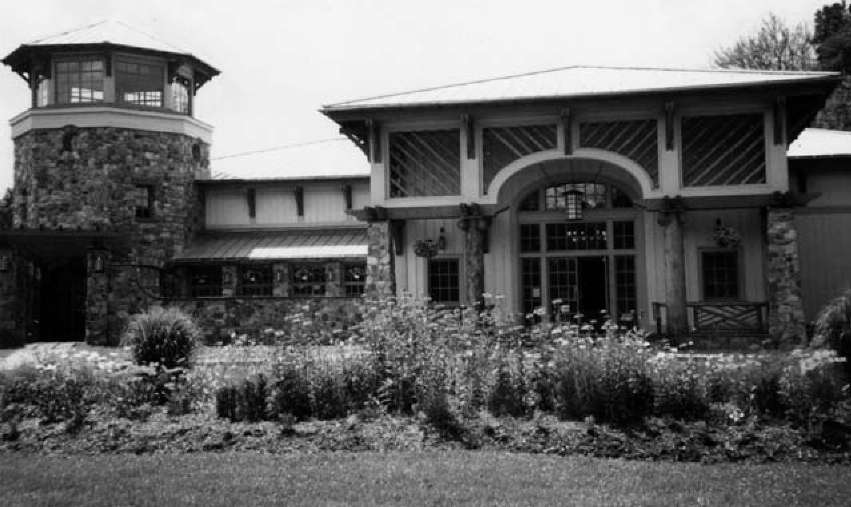
THE ROGER TORY PETERSON INSTITUTE
The legacy of Americas great naturalist and creator of the Peterson Field Guide series, Roger Tory Peterson, is preserved through the programs and work of the Roger Tory Peterson Institute of Natural History (RTPI), located in his birthplace of Jamestown, New York. RTPI is a national nature education organization with a mission to continue the legacy of Roger Tory Peterson by promoting the teaching and study of nature and to thereby create knowledge of and appreciation and responsibility for the natural world. RTPI also preserves and exhibits Dr. Petersons extraordinary collection of artwork, photography, and writing.
You can become a part of this worthy effort by joining RTPI. Simply call RTPIs membership department at 800-758-6841 ext. 226, fax 716-665-3794, or e-mail . You can link to all our programs and activities from there.
Introduction
I N THE MODERN ERA , by any measure, Roger Tory Peterson was a great man. His accomplishments greatly surpass those of his peers. A list of his accolades, awards, and honors would fill several pages of this book. His legendary field guide simplified bird identification so that everyone could understand and enjoy it. Today, millions of people around the world enjoy bird watching because of the simple, methodical identification methods Peterson put into print.
Roger Tory Peterson considered himself a teacher above all else, and his patience with his pupils is legendary. Today the Roger Tory Peterson Institute of Natural History carries on RTPs tradition of educating people about nature.
For me, Rogers reputation paled in comparison with what I learned about him the first time we met. It was at Hawk Mountain, in Kempton, Pennsylvania, in 1988, during that venerable sanctuarys sixtieth birthday celebration. He was the keynote speaker, and after his talk he took his traditional place at the book-signing table. A long line snaked around the presentation tent and out the door, into the night. My father and I waited patiently in linenot to get our field guides signed, but so that my dad, who had met Peterson and communicated with him many times over the years, could introduce me to him.
When our turn came, my dad said, Roger, Id like you to meet our son, Bill the third, an avid bird watcher who has just joined the staff of Bird Watchers Digest as associate editor.
Roger sized me up, shook my hand, and said, Its a pleasure to meet you. Come with me for a moment. We slipped out the tent flap behind his table, leaving a long line of befuddled audience seekers in our wake. Youve got young ears and I dont. Can you tell me what you think of the sounds these katydids are making? They sound quite different from our katydids in Connecticut.
I hardly knew what to think. I knew what a katydid sounded like, but I had never thought about regional differences in their calls. Obviously Roger Peterson had, and he was curious enough about it to seek a second, albeit uninformed, opinion.
Hearing another katydid, Roger exclaimed, There, did you hear that one? Quite a bit thinner and higher than ours in Connecticut! I nodded my assent and we stood for a few minutes morethe worlds most accomplished field guide author and a twenty-six-year-old awestruck young man, listening to insect calls in the dark while hundreds of adoring fans waited a few dozen feet away.
Well, wed better get back inside before theres a riot. Ive still got a lot of books to sign! And with that we reentered the tent. To this day I remain impressed by Roger Petersons insatiable curiosity about nature, his ability to sort out such minute differences in nature, and his kindness to a young bird watcher and editor just starting out. Those minutes alone with him are something I will always cherish.
A decade earlier, in 1978, my parents, Bill and Elsa Thompson, had started Bird Watchers Digest in the living room of our Marietta, Ohio, home. It was the very definition of a family affair. We sent out a mass mailing of sample issues with an invitation to subscribesix issues for seven dollars. My parents sent one of these samples to Roger Peterson and asked for his feedback.
Peterson replied with a lengthy letter, along with his check for a subscription. That letters first sentence, I was delighted to receive the copy of your first issue of the Bird Watchers Digest, sent my parents jumping for joy. What followed were three pages of focused, article-by-article critique, which my parents and the magazines editor, Mary Beacom Bowers, read and reread over the years.
Roger Tory Peterson wrote a regular column, All Things Reconsidered, for Bird Watchers Digest from 1984 until his death in the summer of 1996. This column covered a vast array of topics: some were stories of Petersons birding adventures, others chronicled the lives of certain species or of his peers, and others charted the growth and changes in bird watching. Now, ten years after Petersons death, it seems appropriate to revisit some of his work for the magazine.
I served as managing editor of Bird Watchers Digest under editor Mary Beacom Bowers from 1988 until I assumed the editorship of the magazine, in 1995. Mary and I used to talk about Roger Peterson, and we never failed to marvel at his skills as a writer, which were nowhere near as well known as his skills as an artist, photographer, and lecturer. But Peterson was a writer of uncommon skill and depth. His writing style, like his speaking voice, was clear and gentle; he could tell a story (and he had many to tell) like almost no one else. Here was a man who could make a compelling argument about the beauty of the European starling or the incredible survival skills of the house sparrow with as much style and enthusiasm as if he were writing about the huge penguin colonies of Antarctica.
Reading this collection of Roger Tory Petersons best columns from Bird Watchers Digest will offer some insight into his perspective on the changes he saw in his lifetime. In preparing these columns for re-publication a decade later, we have changed some things to reflect todays realitybird names, for example (the rufous-sided towhee is now the eastern towhee), and the names of organizations and publications. But many other things we have left in their original form, as a sort of time capsule for the reader to open up and examine.
The date at the end of each column is the issue of the magazine in which the column appeared. Not every column was written as an original piece for the magazine, however. Hard at work revising his field guidesworking even on the day he diedPeterson managed to write his column for twelve years, throughout his seventies and early eighties. For some columns, he chose to revise and update material he had written years earlier. Works such as
Next page

